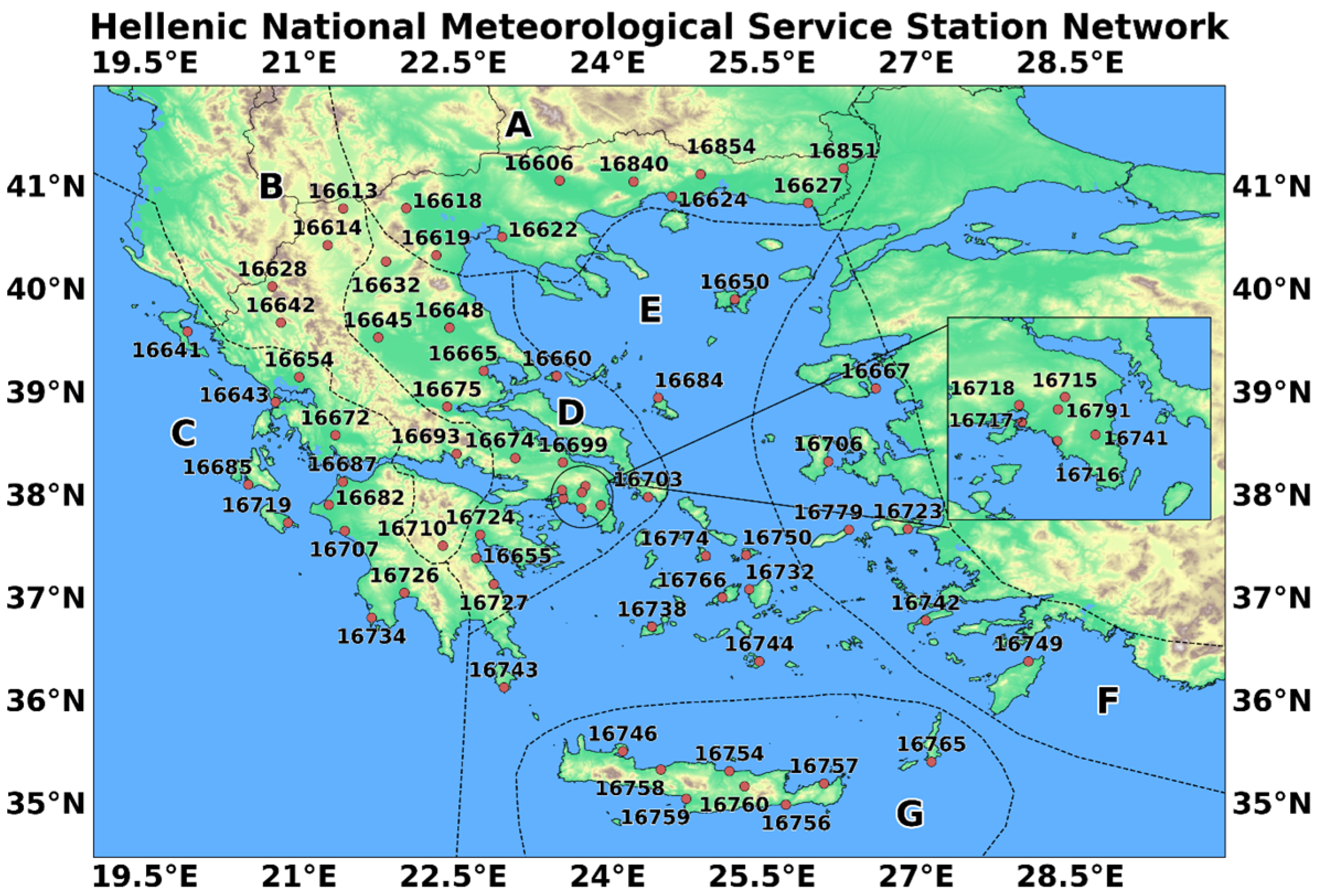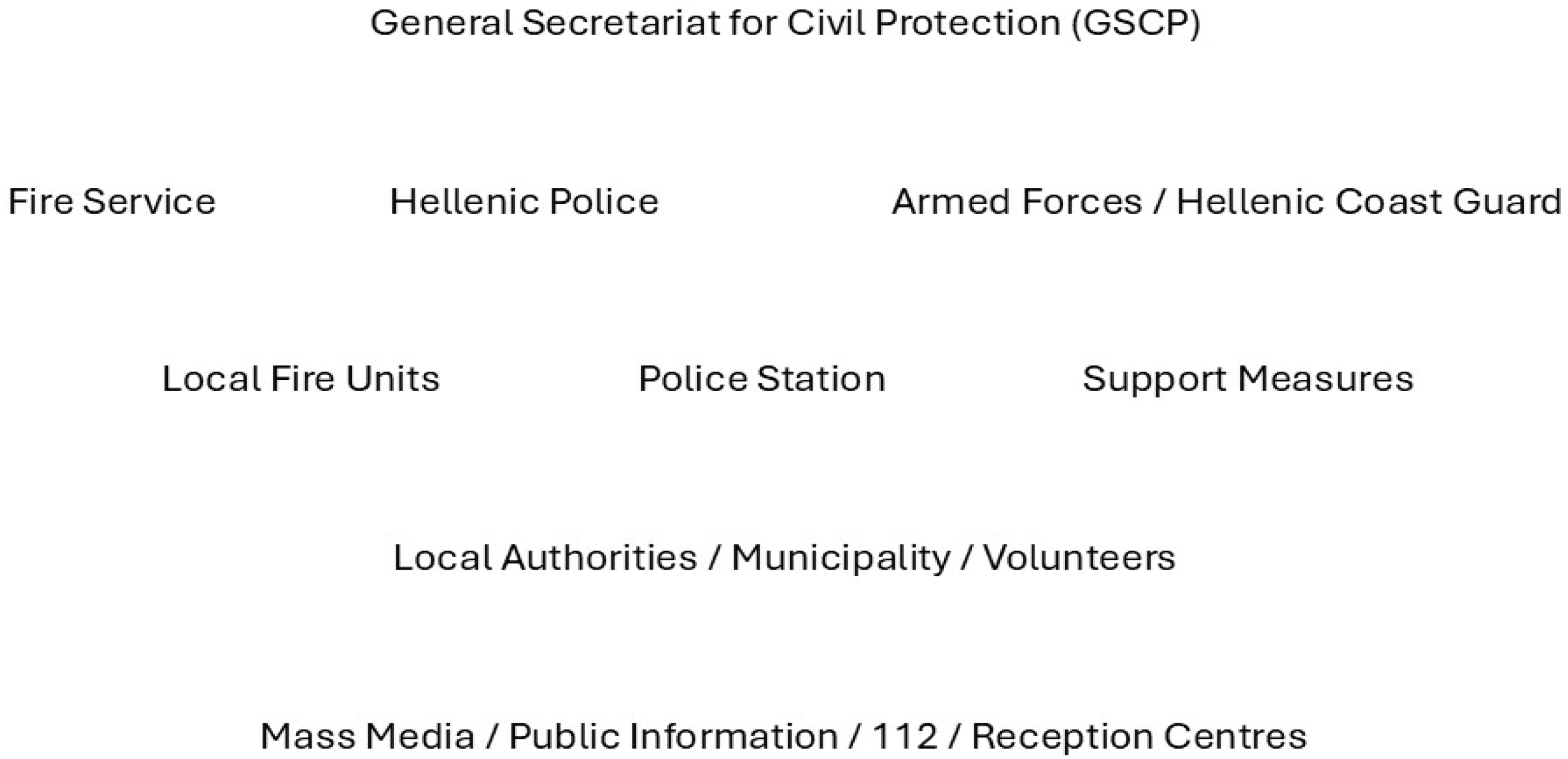The Role of the Hellenic Police in the Management of Natural Disasters: Legislative Framework †
Abstract
1. Introduction
2. Data and Methods
3. Results
4. Conclusions and Policy Recommendations
Author Contributions
Funding
Institutional Review Board Statement
Informed Consent Statement
Data Availability Statement
Acknowledgments
Conflicts of Interest
Abbreviations
| HP | Hellenic Police |
| HFS | Hellenic Fire Service |
| HCG | Hellenic Coast Guard |
| CP | Civil Protection |
| NEAC | National Emergency Aid Centre |
| AF | Armed Forces |
| EMAK | Hellenic Special Disaster Response Unit |
| NCCOM | National Coordination Centre for Operations and Crisis Management |
References
- Boin, A.; Hart, P.T. Public Leadership in Times of Crisis: Mission Impossible? In Public Administration Review; John Wiley & Sons, Ltd.: Hoboken, NJ, USA, 2003; pp. 544–553. [Google Scholar] [CrossRef]
- The Constitution of the Hellenic Republic, Articles 5 Par.2, 25 Par.1, 102. Available online: https://www.hellenicparliament.gr/Vouli-ton-Ellinon/To-Politevma/Syntagma/ (accessed on 3 March 2025).
- Hellenic Republic Civil Protection. Ministry for Climate Crisis and Civil Protection. Legislation. Available online: https://civilprotection.gov.gr/parousiasi-forea/nomothesia (accessed on 15 March 2025).
- Law 4662/2020 “National Mechanism for Crisis Management and Risk Response, Restructuring of the General Secretariat for Civil Protection, Upgrading of the Civil Protection Volunteer System, Reorganization of the Fire Service, and Other Provisions”; Government Gazette FEK A’ 27; Hellenic Republic: Athens, Greece, 2020.
- Kapucu, N.; Garayev, V. Collaborative decision-making in emergency and disaster management. Int. J. Public Adm. 2011, 34, 366–375. [Google Scholar] [CrossRef]
- United Nations Office for Disaster Risk Reduction (UNDRR). 2009 UNISDR Terminology on Disaster Risk Reduction; United Nations: Geneva, Switzerland, 2009; Available online: https://www.undrr.org/publication/2009-unisdr-terminology-disaster-risk-reduction (accessed on 28 March 2025).
- Hellenic National Meteorological Service. The Climate of Greece. Available online: https://www.emy.gr/the-climate-of-greece (accessed on 25 February 2025).
- Ioannidis, P.; Mamara, A.; Armaos, V.; Argiriou, A.A. Long—Term Trends and Variability of Heatwaves in Greece. In Proceeding of the 17th International Conference on Meteorology, Climatology, and Atmospheric Physics—COMECAP 2025, Nicosia, Cyprus, 29 September–1 October 2025. [Google Scholar]
- Presidential Decree 178/2014 “Organization of the Hellenic Police Services”; Government Gazette FEK A’ 281; Hellenic Republic: Athens, Greece, 2014.
- Hellenic Republic. Greek Law 4249/2014 “Reorganization of the Hellenic Police, the Fire Service, and the General Secretariat for Civil Protection, Upgrading of the Ministry of Public Order and Citizen Protection Services, Regulation of Other Matters Under the Ministry’s Jurisdiction, and Other Provisions”; Government Gazette FEK A’ 73; Hellenic Republic: Athens, Greece, 2014.
- Presidential Decree 70/2021 “Establishment of the Ministry of Climate Crisis and Civil Protection and Reallocation of Services and Competences Among Ministries”; Government Gazette FEK A’ 161; Hellenic Republic: Athens, Greece, 2021.
- Greek Law 3938/2011 “Establishment of the Office for the Handling Incidents of Arbitrary Conduct Within the Ministry of Citizen Protection and Other Provisions”; Government Gazette FEK A’ 61; Hellenic Republic: Athens, Greece, 2011.
- Law 3013/2002 “Establishment of the Civil Protection System”; Government Gazette FEK A’ 102; Hellenic Republic: Athens, Greece, 2002.
- Law 2344/1995 “Organization of Civil Protection and Other Provisions”; Government Gazette FEK A’ 212; Hellenic Republic: Athens, Greece, 1995.
- Law 5075/2023 “Reforming of Civil Protection—National Mechanism for Aerial Rescue and Air Medical Transport and Other Urgent Provisions for State Support”; Government Gazette FEK A’ 206; Hellenic Republic: Athens, Greece, 2023.
- Ministerial Decision No. 1299. General Plan of Civil Protection Xenokratis; Hellenic Republic: Athens, Greece, 2003.
- Presidential Decree 151/2004 «General Secretariat for Civil Protection»; Government Gazette FEK A’ 107; Hellenic Republic: Athens, Greece, 2004.
- 5th Edition of the General Emergency Response Plan for Wildfires, Under the Code Name IOLAOS 2”, Developed Within the Framework of the General Civil Protection Plan with the Code Name “Xenokratis”. Available online: https://civilprotection.gov.gr/sxedia-politikis-prostasias/geniko-shedio-antimetopisis-ektakton-anagkon-exaitias-dasikon-0 (accessed on 12 April 2025).


| Rationale for Change | Legislative Act | Brief Description |
|---|---|---|
| 1. Multiplication and intensification of natural disasters (Law 2344/1995) | Law 4662/2020 | Institutionalization of the National Crisis Management Mechanism, covering all phases (prevention, preparedness, response, recovery) |
| 2. Inadequacies of Law3013/2002 Ministerial Decision No. 1299/2003 | Law 4662/2020 | Replacement of the outdated model based on the general oversight of the General Secretariat for Civil Protection, lacking operational clarity |
| 3. European and international obligations | Law 4662/2020 + participation in the EU Civil Protection Mechanism | Alignment with EU requirements, including the development of a National Risk Assessment Plan |
| 4. Need for institutionalized interagency cooperation (Police, Fire Service, Municipalities) | Presidential Decree 178/2014, Law 4249/2014, Law 4662/2020 | Definition of responsibilities for all involved Authorities. Establishment of Coordinating mechanism (such as National Coordination Center for Operations and Crisis Management) |
| 5. Tragic events— Mati wildfire 2018 | Law 4662/2020 | Response to criticism over the system’s failure to act effectively, leading to the acceleration of structural reform |
| 6. Integration of the climate crisis dimension | Presidential Decree 70/2021 Law 5075/2023 | Establishment of the Ministry for Climate Crisis and Civil Protection (sustainable prevention and risk reduction). Reforming C. P. |
| Authority/Teams | Role/Responsibility |
|---|---|
| General Secretariat for Civil Protection | Has a strategic and coordinating role at the national level. |
| Fire Service | Responsible for fire suppression and rescue operations. |
| Hellenic Police | Ensures public order, coordinates evacuations, and manages traffic. |
| Armed Forces—Hellenic Coast Guard | Provide support, equipment and personnel when needed. |
| Local Authorities (Municipalities and Regions) | Play a crucial role at the local level, often in cooperation with volunteers. |
| Volunteers | Offer supportive services, especially in prevention, logistics, and community response. |
| Mass Media/112/Reception Centers | Responsible for public information, early warning, and support of the population. |
Disclaimer/Publisher’s Note: The statements, opinions and data contained in all publications are solely those of the individual author(s) and contributor(s) and not of MDPI and/or the editor(s). MDPI and/or the editor(s) disclaim responsibility for any injury to people or property resulting from any ideas, methods, instructions or products referred to in the content. |
© 2025 by the authors. Licensee MDPI, Basel, Switzerland. This article is an open access article distributed under the terms and conditions of the Creative Commons Attribution (CC BY) license (https://creativecommons.org/licenses/by/4.0/).
Share and Cite
Gerontiotou, I.; Nastos, P.; Argiriou, A.A.; Maroudas, L. The Role of the Hellenic Police in the Management of Natural Disasters: Legislative Framework. Environ. Earth Sci. Proc. 2025, 35, 52. https://doi.org/10.3390/eesp2025035052
Gerontiotou I, Nastos P, Argiriou AA, Maroudas L. The Role of the Hellenic Police in the Management of Natural Disasters: Legislative Framework. Environmental and Earth Sciences Proceedings. 2025; 35(1):52. https://doi.org/10.3390/eesp2025035052
Chicago/Turabian StyleGerontiotou, Isidora, Panagiotis Nastos, Athanasios A. Argiriou, and Leonidas Maroudas. 2025. "The Role of the Hellenic Police in the Management of Natural Disasters: Legislative Framework" Environmental and Earth Sciences Proceedings 35, no. 1: 52. https://doi.org/10.3390/eesp2025035052
APA StyleGerontiotou, I., Nastos, P., Argiriou, A. A., & Maroudas, L. (2025). The Role of the Hellenic Police in the Management of Natural Disasters: Legislative Framework. Environmental and Earth Sciences Proceedings, 35(1), 52. https://doi.org/10.3390/eesp2025035052








